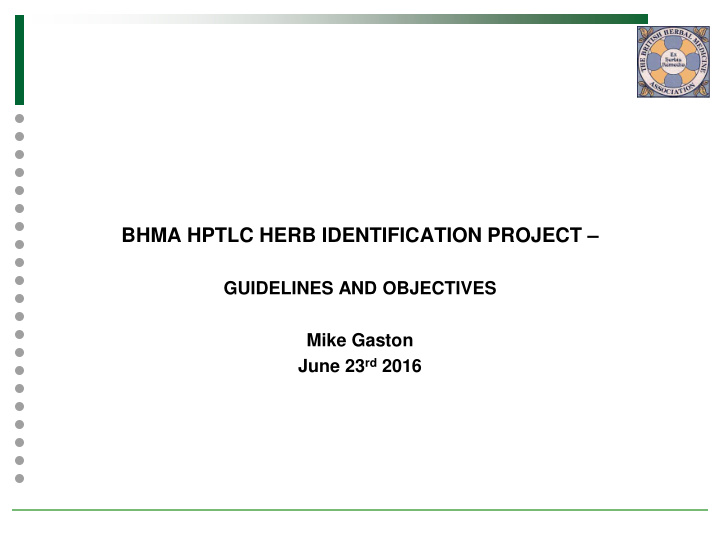



BHMA HPTLC HERB IDENTIFICATION PROJECT – GUIDELINES AND OBJECTIVES Mike Gaston June 23 rd 2016
What is Quality? A material is of the correct quality if it is fit for its intended use . Which means: It is of the correct strength. It is free from contamination and adulteration. It is the correct material.
All my supplies are delivered correctly labelled with identity and strength, they are therefore of the correct quality, so everything is OK? ARE THEY?? A recent study by Heinrich et. al. at University College London on Rhodiola Rosea THRs and Botanical food supplements found about 40% of the botanicals either contained the wrong Rhodiola species, or no Rhodiola at all – one was even found to contain a 5- HTP derivative. Other studies have found similar anomalies, at similar levels, with Milk Thistle, Ginkgo Biloba and Evening Primrose Oil. A St John’s Wort extract has been found by HPLC to have been spiked with synthetic hypericin to enhance its perceived potency.
In order to define more fully just how widespread these issues are, the BHMA decided to commission a study into a number of commercially available herbal products. The technique to be employed was High Performance Thin Layer Chromatography (HPTLC). This is a powerful technique which is capable of providing accurate identification of botanical materials, and their contaminants and adulterants. Unfortunately, there are no commercial companies in the UK with sufficient HPTLC capability, but a Swiss company, CAMAG, have offered to test large numbers of herbal samples to demonstrate the usefulness of HPTLC and an identification tool. And so the CAMAG project was born.
The project objectives To assess the magnitude of quality and identification issues with botanical materials from a number of different sources. To act as an educational tool on the pitfalls of sourcing quality herbal materials. It is NOT To provide marketing data or product comparisons for commercial purposes. To be used for naming and shaming.
The Study Protocol 1. Obtain through normal commercial channels as many different samples containing the target herb as possible. The samples are to include THR products, botanical food supplements, and practitioner supplies. 2. Each sample will be assigned a unique identifier, and all samples shipped to CAMAG in Switzerland, where further identification numbers will be assigned and the samples analysed by HPTLC. 3. The analytical report will be emailed to selected BHMA representatives, who have no commercial affiliations, for review and issue of the final BHMA report. The BHMA representatives are Dr Tony Booker and Mike Gaston. The BHMA report will not identify the sources of any of the samples.
Herbs selected for Study: Milk Thistle. Echinacea We will be looking at: dry powders; dry extracts; liquid extracts; tinctures and as many different dosage forms as possible. The samples have been obtained and are under analysis at CAMAG.
Watch this space for results. THANK YOU!
Recommend
More recommend